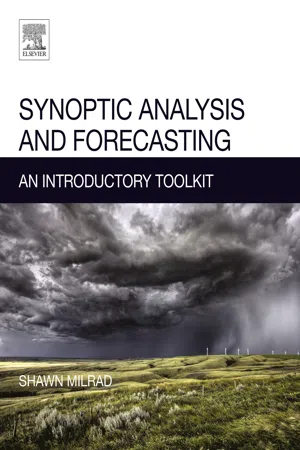
- 246 pages
- English
- ePUB (mobile friendly)
- Available on iOS & Android
About this book
Synoptic Analysis and Forecasting: An Introductory Toolkit provides the bridge between the introductory fundamentals of a meteorology course and advanced synoptic-dynamic analysis for undergraduate students. It helps students to understand the principles of weather analysis, which will complement computer forecast models. This valuable reference also imparts qualitative weather analysis and forecasting tools and techniques to non-meteorologist end users, such as emergency/disaster managers, aviation experts, and environmental health and safety experts who need to have a foundational knowledge of weather forecasting.- Presents the fundamentals of weather analysis and forecasting- Offers clear accessible writing aimed at students from a variety of mathematical backgrounds- Discusses the reading and interpretation of surface observations and METAR code, processes associated with the motion and intensity of cyclones and anticyclones, and quantitative and/or qualitative diagnosis of processes associated with ascent and descent
Frequently asked questions
- Essential is ideal for learners and professionals who enjoy exploring a wide range of subjects. Access the Essential Library with 800,000+ trusted titles and best-sellers across business, personal growth, and the humanities. Includes unlimited reading time and Standard Read Aloud voice.
- Complete: Perfect for advanced learners and researchers needing full, unrestricted access. Unlock 1.4M+ books across hundreds of subjects, including academic and specialized titles. The Complete Plan also includes advanced features like Premium Read Aloud and Research Assistant.
Please note we cannot support devices running on iOS 13 and Android 7 or earlier. Learn more about using the app.
Information
Meteorological Conventions
Abstract
Keywords
1.1 Time Zones and Zulu (Z) Time
| Time Zone | Cities Included | Hours Behind Z | 00Z | 12Z |
| Atlantic Standard Time (AST) | Halifax, Hamilton (Bermuda), San Juan (Puerto Rico) | 4 | 8 p.m. AST | 8 a.m. AST |
| Eastern Standard Time (EST) | New York City, Miami, Toronto | 5 | 7 p.m. EST | 7 a.m. EST |
| Central Standard Time (CST) | Chicago, Houston, Winnipeg | 6 | 6 p.m. CST | 6 a.m. CST |
| Mountain Standard Time (MST) | Denver, Albuquerque, Calgary | 7 | 5 p.m. MST | 5 a.m. MST |
| Pacific Standard Time (PST) | Los Angeles, Seattle, Vancouver | 8 | 4 p.m. PST | 4 a.m. PST |
| Alaska Standard Time (AKST) | Juneau, Anchorage, Nome | 9 | 3 p.m. AKST | 3 a.m. AKST |
| Hawaii Standard Time (HST) | Honolulu, Hilo, Pearl City | 10 | 2 p.m. HST | 2 a.m. HST |
1.2 Common Units of Measurement
Table of contents
- Cover image
- Title page
- Table of Contents
- Copyright
- Preface
- Acknowledgments
- 1: Meteorological Conventions
- 2: Surface Observations and Instrumentation
- 3: METAR Code
- 4: Upper-Air Observations
- 5: Isopleths and Upper-Tropospheric Charts
- 6: Lower-Tropospheric Charts
- 7: Upper-Tropospheric Processes
- 8: Lower-Tropospheric Processes
- 9: Putting It All Together
- 10: Fronts and Drylines
- 11: Satellite Imagery
- 12: Radar Imagery
- 13: Thermodynamic Diagram Basics
- 14: Thermodynamic Diagram Interpretation
- 15: Weather Forecasting Basics
- Index
